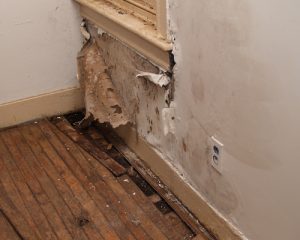Excessive Moisture and Pests
By Chris Williams on December 6, 2011.
Q. We had a carpenter ant problem. The pest control technician who treated our home said that carpenter ants are usually associated with moisture problems in your home but he didn’t tell us where to look for moisture problems. How do we know if we have moisture problems that could attract pests?
 A. It’s true that many pests are attracted to high moisture levels. Their bodies dry out quickly in conditions that are too dry. In homes, they usually end up in crawlspaces, garages, basements, laundry rooms, and near sinks, floor drains, hot water heaters, and other places with high humidity. Insects that infest wood, like carpenter ants and termites, often begin their infestations in wood that is damp–usually from a plumbing leak, roof leak, or poor drainage. Even if the wood is currently dry, if it was once water-damaged, then it is softer and easier for pests to chew and tunnel in. Sometimes, an infestation can move from areas of damp wood into areas of perfectly dry wood.
A. It’s true that many pests are attracted to high moisture levels. Their bodies dry out quickly in conditions that are too dry. In homes, they usually end up in crawlspaces, garages, basements, laundry rooms, and near sinks, floor drains, hot water heaters, and other places with high humidity. Insects that infest wood, like carpenter ants and termites, often begin their infestations in wood that is damp–usually from a plumbing leak, roof leak, or poor drainage. Even if the wood is currently dry, if it was once water-damaged, then it is softer and easier for pests to chew and tunnel in. Sometimes, an infestation can move from areas of damp wood into areas of perfectly dry wood.
Insects are not the only pests that thrive in damp areas. Molds and other fungi can grow only where it’s damp. The single best way to find moisture problems in your home is to use a moisture meter. Moisture level readings above 20 percent indicate a moisture problem that needs to be corrected. Besides a moisture meter, you can use your eyes, ears, and nose to look for the following indications of moisture problems:
· Moss, lichens, or a greenish discoloration on the roof
· Water-stained wood on fascia boards, gables, wood junctions, or window frames
· Greenish discoloration on siding
· Crumbling of bricks or masonry
· White, crystalline deposits on bricks
· Water standing around foundation
· Areas of damp soil around the foundation when other ground is dry
· Blistered or peeling paint on siding or interior walls
· Water stains on patio or porch
· Wet crawlspace soil
· Condensed moisture on the bottom side of floor insulation
· Flooring that has settled, is no longer level, has separated from the baseboards, or feels spongy when walked on
· “Sweating” on walls or floors
· Rust on metal window or door frames
· Mildew on walls or ceiling
· Musty smell
· Wood that has a soft, dull sound when struck with a hammer
· Wood that feels soft and breaks in short lengths across the grain when pried with a screwdriver or pick
· Wood that is dark brown and cracked across the grain into cubes (brown rot)
· Wood that is spongy with a whitish, bleached look (white rot)
· Powdery, colored molds on the surface of the wood (surface mold)
· Yellowish-white, fanlike structures on the surface of the wood (water-conducting fungi)
· Small mushrooms growing on wood
If you’ve noticed any of these symptoms of excessive moisture and you need professional follow-up, give Colonial a call. If staining and wood damage was present when you moved into the house, it may be an old problem that has since been corrected. Our pest control pros will use a moisture meter and their years of experience to determine whether you have a moisture problem and a moisture pest problem. The good news is that finding and correcting the moisture problem will often eliminate the pest problem as the area dries out.